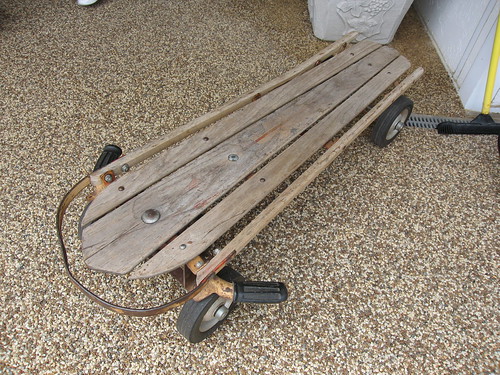Long-promised video here!
Here’s an historical post. The key part is the video below which was created in 1972.
The video has been promised to accompany my chapter in the Festschrift for Ursula Bellugi and Ed Klima published in 2000. In that chapter I analyzed Lou Fant’s live interpretation of a spoken reminiscence.  I was the (English) speaker; Lou used American Sign Language (ASL). My story told about trying to ride a Flexiflyer down a steep U-shaped driveway and back up.
Spoiler alert: Â I crashed.
Key Findings:  Fant managed to get the description of the relationship of the house, the driveway and the sled’s riders correct, if mirror-image of the actual space, without having seen the place, without any gestures from me (the speaker), and with the English input message being pretty sketchy. And the cool part? He continues still interpreting for at least a full minute, before he commits himself to those spatial relationships.
It takes a village…
Support from the National Institutes of Health and National Science Foundation over the past 40 years fueled the research of Klima and Bellugi, and many of their students and colleagues. I was privileged to be a member of the laboratory research staff from Fall 1970 through Spring 1973, and an irregular visitor thereafter. This video was created in 1972 at the Salk Institute. It was preserved during the early 1980s (on VHS cassette). It was digitized in 2000 with help from Stanford’s Academic Technology Laboratory (a support facility for faculty), and from Treehouse Video. I’m thrilled to report that the .mov (Quicktime format) video still plays, and has now been uploaded to YouTube, and is presented for your viewing pleasure, with gratitude to all those who helped along the way.
Pack rat unveiled
I saved that bit of video from Fant’s first (or perhaps second) visit to Salk Institute on one of my irregular visits back to La Jolla. When copying from helical scan 1/2″ videotape to VHS cassette, I remembered that I had consciously chosen to tell about an event that no one in the room had heard before, one from my childhood, so that it would be a genuine listening and viewing experience for both the hearing and deaf people present (not a retelling of a familiar story). Of course the interpreter hadn’t heard this story before, and he didn’t have much context about me either. I thought I had been quite clear about the physical space – I could picture it even many years after the event – how the house was situated, where the driveway started, turned, and ended at the street again, and what it was like to ride the wheeled sled. On listening again, I realize that the physical space is difficult to imagine if you were depending on the spoken message only.
Interpreter stays vague for a full minute
Our visitor, the exemplary interpreter and sign language educator, Lou Fant agreed to contrast “transliteration” and “interpreting.” I’ll offer a brief definition of these terms, knowing full well that other experts out there can elaborate in greater depth. Transliteration is a more English-influenced rendering into signs; interpreting is provides simultaneous translation into ASL, a different language, with English influence kept to a minimum. The excerpt shown here was the first part of the illustration of “interpreting.” The key surprise for me in reviewing the video was that Fant managed to keep the message vague as he worked out how all the different parts of the space described fit together. The ability to be vague had never been catalogued as a characteristic of the competent interpreter before. When I told him I was planning to look at this bit of video at long last and asked whether he’d like to see what I was finding and writing about him, he gave his blessing to my work without his review. I’m delighted to be able to present his spontaneous interpretation now almost 40 years after it was first produced.
And thanks to an interpreting instructor who uses the chapter from the Festschrift for asking where that video is. Â Rachel, it’s here now.
